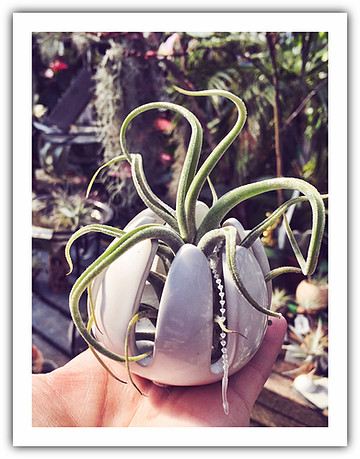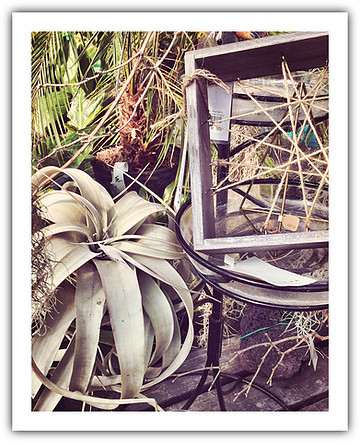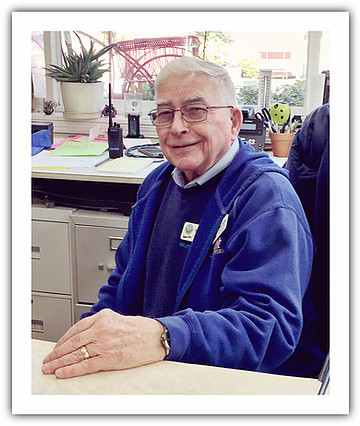Since becoming a “Modern Air Head,” it seemed that I should learn a thing or two about Tillandsias: The tiny beauties for which I’ve designed special planters. Tillandsias, as it turns out, are having a moment. What I do know: They’re crazy cute and don’t need dirt, so don’t let their Pinterest-perfect-prettiness fool you! They’re tough, no-nonsense, drought-tolerant plants. If, like me, you consider yourself a serial, house-plant killer or perhaps just a slightly inattentive indoor gardener, air plants are for us! Now that I have about ten varieties at home, I wanted to know more.

Anyone can get online and Google air plants. However, in my search for information, I yearned to connect with a human being, preferably someone with dirt under their fingernails, a deeply lined, sun and wind-worn face, and, if they happened to smell of fertilizer – cool!
As if I’d ordered him up from Central Casting, there was Sam Rader in The Answer Shack at Valley Nursery. I’m not certain that he, in fact, had dirt under his nails. Sam seemed pretty tidy overall. He didn’t smell of anything as unpleasant as fresh fertilizer, but all the same, there he was: Bespectacled and beaming among the botany books, binders, posters, products, and informational handouts, a kindly, mild-mannered gentleman with a passion for plants, trees, Tillandsias, and (thank goodness) teaching!
The Answer Shack is a charming yellow shed with white trim, offering a hundred square feet of inspiration, ideas, and commonsense garden talk. Professional, certified horticulturists, like Sam, sit behind a Formica-topped desk every day of the week and, on bustling spring and summer weekends, a standing room.
Sam has worked at Valley Nursery for over two decades, and, when I walked in with my questions about Tillandsias, his eyes lit up like it was his first day on the job. Right off the bat, he told me that Tillandsias bloom spectacularly when fertilized regularly (granted, it may take two to three years!). He swiftly spun 180 degrees in his swivel chair to face the computer screen and jumped online to show me the dazzling spectrum of showy, tropical blooms. Oh, joy!
My little ones haven’t bloomed yet, but I’ve only had air plants for a hot minute, and now, I have #goals! Sam assured me that, with low nitrogen, high phosphorous, high potassium fertilizer (6-30-30), they will bloom. “Mix a tiny bit of the fertilizer in water and mist. Don’t soak!” Sam prefers misting Tillandsias, versus soaking, so that the crown does not stay wet and rot the plant. The blooms will last four to six weeks and then, they die. Die? Just like that, as I was reaching a fever pitch, imagining my dazzling bloomers, my shoulders visibly slumped. I want them to bloom, not die.

Please say it ain’t so, Sam! “Not to worry,” he says, “Before they cross over, Tillandsias send out “daughter” plants at their base, which eventually produce beautiful blooms of their own.” Sam’s favorite air plant? Xerographica: “The big ones!” He also likes Tillandsia Bulbosa because, “They’re kind of neat and look like fish if you hang them sideways and put those little “googlie” eyes on them.”
Among the many fascinating and fun facts that I learned from Sam is that you can attach air plants to just about anything with a dab of glue. He recommends using Liquid Nails and warns against using a hot glue gun, which will burn the plant tissue. Apply the glue to the base of one of the leaves (it won’t hurt the plant) and then attach it to a magnate, shell, or piece of driftwood. After talking Tillandsias for fifteen minutes or so, I turned my questions to Sam. It was obvious that he had an encyclopedic knowledge of plants, shrubs, and trees of all kinds. What made Sam bloom?
Before Sam became interested in all that grows on the ground, he spent time in the Navy on water. “No, not on or even near water,” Sam corrected, “but behind a desk.” He hated it. After leaving the Navy, Sam wasn’t quite sure what he wanted to do, but he was certain it wouldn’t involve sitting behind a desk. Much to his wife’s chagrin, after a long bout of doing nothing, Sam began mowing lawns for $4.50 an hour.
Eventually, the gentleman that Sam mowed lawns for suggested that he take horticultural classes at South Seattle Community College, and so, he did. As part of the coursework, Sam interviewed people in the industry and went to Valley Nursery to interview the owner, Brad. This interview was his first contact with Valley. Then, Sam explains, “I got on at a job at a nursery down in Bremerton for eight years until they closed.” Because he lived in Poulsbo, he eventually took a job with Brad. Sam proudly states, “Next month, I’ll start my twenty-fourth year. I only work a couple days a week, but it isn’t work if you like what you’re doing – it’s fun. I enjoy being here. I like coming here.”


Sam says most of the questions he gets at The Answer Shack are the same as they were thirty years ago. He explains, “It was Brad’s idea to have an answer shack, where people could come and get guidance on plant diagnosis, chemicals to use, what not to use, landscape design, sources for work, and just about any kind of information.” Sam laughs and says he even gets directional questions like, “How do I get to Sequim from here?”, but affirms, “It’s fun, and that’s what makes it a good place to work.”
“The Answer Shack is a madhouse during spring and summer. Between walk-ins, the phone, the radio [employees talk to one another via radio], it’s hard to take time with anyone,” says Sam. However, the store policy from Brad is clear: “When that phone rings, the person in front has priority because they got out of bed, got dressed, and took the time to come in.”
Sam says that you can tell it’s a good place because of the longevity of the people who work there. I can tell it’s a good place because it’s where Sam works.
This article was originally published on Mo-Minski.com.
OTHER ARTICLES BY DENISE:
Suggested Reading List for April Poetry Month
Neither Snow nor Rain nor Heat nor Gloom of Night (…but mostly snow)
History, Community and Art Converge at Pleasant Beach Village
New Sculptures in Familiar Places: Public Art Installations on Bainbridge Island
Green Light Garage: The Motherboard
Denise’s Favorite Virtual Gallery Tour: The National Cowboy Western & Heritage Museum

ABOUT DENISE STOUGHTON INSPIRED by globe-trotting, day tripping, found objects and high fashion, Denise has been designing home decor for two decades. Originally from the island of Manhattan, she traded concrete and glass skyscrapers for skyscrapers of the deciduous and coniferous variety and now lives happily on Bainbridge Island with her Chihuahua, Tula. Interior Design has and always will be her first love. She studied (and later, taught) at the Fashion Institute of Technology in NYC. Denise writes a blog for Mercury Michael and is also a member of AHB’s Public Art Committee – placing public art in public spaces.